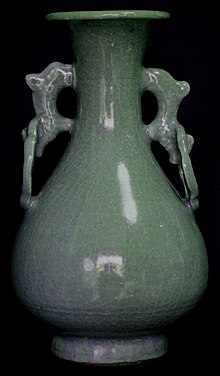Longquan celadon



Longquan celadon (龍泉青瓷) waa la a green-glazed Chinese ceramic parɛɛ kaŋa, ka a West ka ba boɔla o ka celadon bee greenware, bomaale boŋ ba naŋ maale a yi a yuoni 950 wa tɔ 1550. A kilns da maŋ be la Lishui prefecture naŋ be a southwestern Zhejiang teŋe paaloŋ naŋ be a south of China, aneŋ a north of Fujian teŋgane paaloŋ. A de lantaa poɔ a e wo 500 kilns la ka ba nyɛ,[2] ka lɛ vɛŋ ka a Longquan celadon bomaale zie waa a ceramic saaŋkonoŋ bomaale zikpoŋ kaŋa naŋ be a China paaloŋ poɔ. "Longquan-type" waa la a tɛɛme ŋa ba naŋ noŋ, te kyaare ne a yeli booraboora, bee ŋmaa poɔ ka o waa "southern celadon",[3] aŋa kilns naŋ da waa yaga a be a north China a maala Yaozhou ware bee mine Northern Celadon wares. A waa ŋa yeni yɛlɛ yaga poɔ, kyɛ paaŋ taa tɛɛ tɛɛ mine meŋ a yi a Longquan-type celadon eŋa, aneŋ meŋ ka a maaloo maŋ do saa kyɛ leɛ sigi meŋ wɔgre mine naŋ pare.[4]
Technical aspects aneŋ decoration
[maaleŋ | Maale eŋ yizie]Daare kyɛ wuoro lannataa
[maaleŋ | Maale eŋ yizie]
Dabaŋkoroŋ
[maaleŋ | Maale eŋ yizie]
Baŋ ka
[maaleŋ | Maale eŋ yizie]Sommo yizie
[maaleŋ | Maale eŋ yizie]Naŋ kanna gɛrɛ
[maaleŋ | Maale eŋ yizie]- Regina Krahl, et al., Chinese Ceramics in the Topkapi Saray Museum, Istanbul, 3 vols, London, 1986
Tɛmpileti:Song dynasty topicsPage Module:Coordinates/styles.css has no content.28°04′30″N 119°07′15″E / 28.07500°N 119.12083°E / 28.07500; 119.12083Tɛmpileti:Authority control
- ↑ http://www.britishmuseum.org/research/collection_online/collection_object_details.aspx?objectId=3179870&partId=1
- ↑ Krahl and Harrison-Hall, 13; Gompertz, 158 has "over 200 kiln sites" showing the pace of Chinese archaeology in recent decades, and perhaps counting groups rather than individual kilns; Medley, 147, on their locations
- ↑ Medley, 146
- ↑ Medley, 115-118; Gompertz, 159, 98-125; for some reason one is typically capitalized and the other not.
